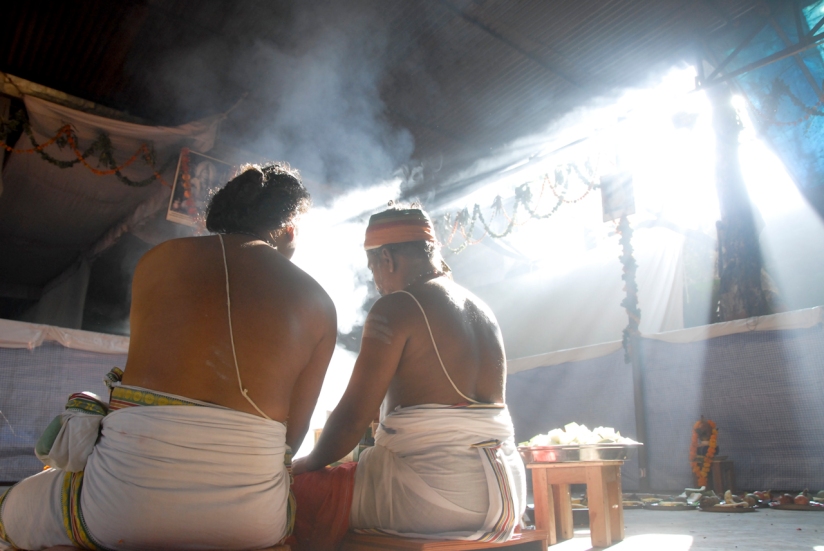Yagno vaii shreshthatamam karma
(Yagna is the most sacred deed)
Rishikesh
Dussera, Oct 2010

Yajno hi ta indra vardhano bhooduta (Hey my soul! Yajna is the instrument of the uplisftment of your intellect.)
For 10 auspicious days of the Dussehra festival every year, Shata Chandi Maha Yagna is performed in Gayatri ashram situated at the banks of Ganges. It is organised by a marwari business family from Mumbai. A team of highly learned priests from Chennai and Kanchi travel to Rishikesh to perform this sacred maha yagna. My closeness to this family developed as we belong to the same alumnus and share some common interests.
Having grown up in a gurukul system, like in the ancient times, I have been lucky to sit through Yagna’s through my years at Prashanti Nilayam ashram. Naturally, i did not want to miss this opportunity at Rishikesh. It’s an elevating experience to engross in a yagna, the effect of which goes beyond the scope and understanding of science. Over the years i have realised that to really benefit from being present in a Yagna, one has to tune their mind and intellect to the spiritual ambience of the Yagnashala. Like, A clay brick would absorb completely when placed on a puddle of water. What about a stone?
Upanishads contain an interesting story illustrating the power of Yagna.
Once a highly accomplished Vedic scholar by name Bandi put a challenge before king Janaka that his proficiency on the Vedas was so strong that he could defeat anyone in the kingdom in scholarly argument. The condition was that whoever looses the argument must walk into the river and give up his life. King Janaka readily accepted it as he was confident he had the best scholars amongst his people. However, day after day the king lost best of the Brahmins and scholars as they all walked into the river after accepting defeat from Bandi.
At that point, Ashtavakra (person with eight bends in the body) walked into the assembly and took up the challenge. The people broke into laughter and questioned how a deformed bodied person would manage to defeat such a great scholar. Nevertheless the king granted him the chance to argue and in due course Ashtavakra defeated Bandi in intellectual argument. As his reward he demanded that all the Brahmins and sages be brought back to life. Bandi then revealed that all the scholars who walked into the river are not dead but were actually sent to the nether world to perform an important ritual by lord Varuna. By this time, Varuna’s ritual was complete and at Bandi’s request, Varuna bade the sages and Brahmins farewell and brought them to surface.
The big question to this story is that from where did Ashtavakra get the wisdom to defeat the unconquerable Bandi?
Legend has it that before Ashtavakra walked into king Janaka’s assembly, he had to cross a yagnashala at the entrance of the palace. This was the place of Nitya Yagna (yagna that never stops). The power of yagna is such that by mere crossing the nitya-yagna, Ashtavakra obtained the wisdom and intellect to defeat Bandi. Ashtavakra went on to become a great sage and realised Brahman.
Upanishads say that the very mechanism of the universe – encompassing the movement of heavenly spheres, the rising and setting of the sun with precision, the formation of sky, fire, water and earth and the gift of varied vegetation, the constant source of energy, the coolness of the moon, the onset of the seasons in a set cycle, the rainfalls to impart food unto us, etc. – are all part of the Yagna performed by our Creator.
The word yagna is derived from the Sanskrit verb yaj, which has a three-fold meaning: worship of deities (devapujana), unity (saogatikarana) and charity (dana). The philosophy of yagna teaches a way of living in the society in harmony.
We defile mother earth by all our waste in a million forms. It therefore behoves us to give something back and it would be done best through performance of Yagna. The purpose of Yagn is expansion. When ghee and samagri is offered in the fire of Yagna, they spread their ingredients in the environment and benefit the entire neighbourhood by spreading the incense and removing the impurities in the atmosphere. The Vedic prayers inspire the performer of Yagna to awaken his inner noble qualities.
Healing with Sound and Energy
The Atharva veda deals with the sound therapy aspects of the mantras. They can be used for the treatment of the ailing human system at the physical, psychological and spiritual levels. The Samaveda focuses on the musical chanting patterns of the mantras and the subtle form of yagna by defining the latter as the process of mental oblation on the surface of internal emotions through the cosmic radiations of the omnipresent subtle energy of sound.
The effects of yagna include treatment of various diseases and the removal of atmospheric pollution. As the natural fertilizers add to the fertility of soil, the unique confluence of the power of mantra, thermal force and sublimated herbal energy in yagna increases the vital energy (prana) in the atmosphere while purifying the air. This prana is inherent in the air and the flow of fresh air in the morning has been found to be rich in prana. The larger the scale of yagna and the longer their duration, the greater would be these effects.
The parjanya (Rain-cloud) generated by yagna augments the level of prana in the air. This effect is not only condensed around the yagnashala but is also prevalent in the wider space and continues to expand with the flow of air with the process of yagna. Its prana, its essence, its energy, is also present in the water contained in the clouds. This is showered in the form of rain and thus gets absorbed in the soil, crops and vegetation. The soil irrigated by it is found to be more fertile and the grains, fruits and vegetables grown there are tastier and have higher nutritive value. The milk of the cows which graze the grass grown on such lands is also of excellent quality. Drinking the milk and eating the fruits and vegetables energised by yagna increases our stamina, resistance against infections and diseases, and mental astuteness.
Today, there are only a minority of these extremely gifted and dynamic brahmins who have pledged their lives to preserve and practice the profound vedic knowledge of yore. They truly understand that this knowledge is invaluable and have decided to foster it despite the opportunity cost of making a so-called-brilliant-carrer that modern day MNC culture has to offer.
Each of these Brahmins are highly accomplished in their education and practice. Amongst them are MA’s and PHD’s in sanskrit & vedas. They have a kind of memory which can at best remain on our wish list. They follow extremely strict rules for the rituals that seemingly look harsh on their own body. During the course of this yagna, i got to know that the two main priests performing the Yagna were living on just carrot and cucumber once a day for the entire month. During poornahuti(final set of offering), the fire leaps high causing extreme heat. At a time when we were maintaining safe distance from the yagnakund it hardly seemed to bother them. It is all to do with a strong mind and not necessarily a strong body. Seemingly.

This video is actually a compilation of a photo stream of the maha-poornahuti happening on the last day of the yagna. Enjoy the darshan!












